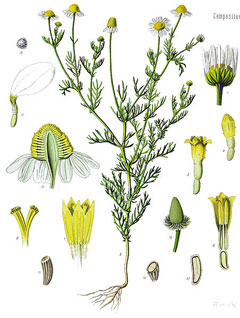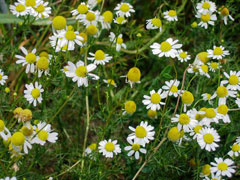 |
|
|
 |
| http://de.wikipedia.org/wiki/Benutzer:Mussklprozz |
Translate this page:
Summary
UPDATE 23/2/12: Matricaria recutita L. is a synonym of Matricaria chamomilla L.
Physical Characteristics

 Matricaria recutita is a ANNUAL growing to 0.5 m (1ft 8in) by 0.3 m (1ft).
Matricaria recutita is a ANNUAL growing to 0.5 m (1ft 8in) by 0.3 m (1ft).
See above for USDA hardiness. It is hardy to UK zone 6 and is not frost tender. It is in flower from June to July, and the seeds ripen from July to August. The species is hermaphrodite (has both male and female organs) and is pollinated by Bees, flies.
Suitable for: light (sandy), medium (loamy) and heavy (clay) soils, prefers well-drained soil and can grow in nutritionally poor soil. Suitable pH: mildly acid, neutral and basic (mildly alkaline) soils and can grow in saline soils.
It cannot grow in the shade. It prefers dry or moist soil.
UK Hardiness Map
US Hardiness Map
Synonyms
Matricaria chamomilla. Auct. Chamomilla recutita. (L.)Rauschert.
Plant Habitats
Cultivated Beds;
Edible Uses
Edible Parts:
Edible Uses: Condiment Tea
The young sprigs are used as a seasoning[15]. The dried flowers are used to make herb teas[21, 37]. It is aromatic but with a very bitter flavour[4].
References More on Edible Uses
Medicinal Uses
Plants For A Future can not take any responsibility for any adverse effects from the use of plants. Always seek advice from a professional before using a plant medicinally.
Anodyne Antiinflammatory Antiseptic Antispasmodic Carminative Cholagogue Diaphoretic Homeopathy
Nervine Stomachic Tonic Vasodilator
German camomile is a well known herbal remedy and is much used in the West. In particular it is an excellent herb for treating various digestive disorders, nervous tension and irritability and is also used externally to treat skin problems[254]. An infusion of the flowers is taken internally as an anodyne, anti-inflammatory, antiseptic, antispasmodic, carminative, cholagogue, diaphoretic, emmenagogue, febrifuge, sedative, stomachic, tonic and vasodilator[7, 218, 238]. An infusion is particularly useful as a stomachic, nervine and sedative for young children, especially when they are teething[238]. It is also used in the treatment of irritable bowel syndrome, Crohn's disease, peptic ulcers and hiatus hernia[254]. In large doses, or when taken regularly for several times each day, the tea can be emetic[218] and can also cause the symptoms it is intended to cure[232]. The flowers are also used externally to treat wounds, sunburn, burns, haemorrhoids, mastitis and leg ulcers[238]. The flowers are harvested when fully open and are dried for later use[254]. The flowers contain various volatile oils including proazulenes[254]. Upon steam distillation these proazulenes produce chamazulene, this is remarkably anti-allergenic and is useful in the treatment of asthma and hay fever[254]. The flowers are sometimes added to cosmetics as an anti-allergenic agent[238]. The whole plant, harvested when in flower, is used to make a homeopathic remedy[232]. It is especially suited to teething children and those who have been in a highly emotional state over a long period of time[232]. The German Commission E Monographs, a therapeutic guide to herbal medicine, approve Camomile for coughs and bronchitis, fevers and colds, inflammations of the skin, inflammation of the mouth and pharynx, tendency to infection - improve immunity, wounds and burns (see [302] for critics of commission E).
References More on Medicinal Uses
The Bookshop: Edible Plant Books
Our Latest books on Perennial Plants For Food Forests and Permaculture Gardens in paperback or digital formats.

Edible Tropical Plants
Food Forest Plants for Hotter Conditions: 250+ Plants For Tropical Food Forests & Permaculture Gardens.
More

Edible Temperate Plants
Plants for Your Food Forest: 500 Plants for Temperate Food Forests & Permaculture Gardens.
More

More Books
PFAF have eight books available in paperback and digital formats. Browse the shop for more information.
Shop Now
Other Uses
Dye Essential Hair Liquid feed Repellent Strewing
An infusion of the flowers is used as a hair shampoo, especially for fair hair[14, 20, 168]. It is also used as a liquid feed and general plant tonic, effective against a number of plant diseases[14, 18, 20]. The flowers are also an ingredient of 'Quick Return' herbal compost activator[32]. The whole plant was formerly used as a strewing herb[4, 168]. The whole plant is insect repellent[14, 20]. An essential oil from the whole plant is used as a flavouring and in perfumery[46]. Yellow to gold dyes are obtained from the flowers[168].
Special Uses
Dynamic accumulator Scented Plants
References More on Other Uses
Cultivation details
An easily grown plant, it succeeds in any well-drained soil in a sunny position[200]. It prefers neutral to slightly acid conditions and succeeds in poor soils[238]. It usually self-sows freely when well-sited[K]. Chamomile has a long history as a gentle and effective folk medicine for a wide variety of disorders, being especially effective and safe for children[K]. There is some confusion between this plant and Chamaemelum nobile as to which is the genuine camomile. This species is said to be more bitter and inferior to Chamaemelum nobile in some reports[200] and to be more active medicinally in other reports[9, 238]. Both have similar properties and can probably be used interchangeably[K]. The whole plant has a pungent aroma[245].
References Carbon Farming Information and Carbon Sequestration Information
Temperature Converter
Type a value in the Celsius field to convert the value to Fahrenheit:
Fahrenheit:
The PFAF Bookshop
Plants For A Future have a number of books available in paperback and digital form. Book titles include Edible Plants, Edible Perennials, Edible Trees,Edible Shrubs, Woodland Gardening, and Temperate Food Forest Plants. Our new book is Food Forest Plants For Hotter Conditions (Tropical and Sub-Tropical).
Shop Now
Plant Propagation
Seed - sow spring or autumn in situ[238]. Germination should take place within 3 weeks.
Other Names
If available other names are mentioned here
Native Range
TEMPERATE ASIA: Afghanistan, Cyprus, Iran, Iraq (north), Israel, Lebanon, Syria, Turkey, Russian Federation-Ciscaucasia (Ciscaucasia), Azerbaijan, Georgia, Russian Federation (Dagestan), Russian Federation-Western Siberia (Western Siberia), Russian Federation-Eastern Siberia (Eastern Siberia), Kazakhstan, Kyrgyzstan, Uzbekistan, Mongolia, China (Anhui Sheng, Hebei Sheng, Jiangsu Sheng, Liaoning Sheng, Shaanxi Sheng, Shandong Sheng, Sichuan Sheng, Xinjiang Uygur Zizhiqu) TROPICAL ASIA: India (Himachal Pradesh, Jammu and Kashmir, Punjab, Uttar Pradesh) EUROPE: Denmark, Finland, United Kingdom, Norway, Sweden, Austria, Belgium, Switzerland, Czech Republic, Germany, Hungary, Netherlands, Poland, Slovakia, Russian Federation (European part), Belarus, Ukraine (incl. Krym), Albania, Bulgaria, Bosnia and Herzegovina, Greece (incl. Crete), Croatia, Italy (incl. Sardinia, Sicily), Montenegro, Romania, Serbia, Slovenia, Spain, France (incl. Corsica), Portugal AFRICA: Algeria, Morocco
Weed Potential
Right plant wrong place. We are currently updating this section.
Please note that a plant may be invasive in one area but may not in your area so it's worth checking.
Conservation Status
IUCN Red List of Threatened Plants Status :

Growth: S = slow M = medium F = fast. Soil: L = light (sandy) M = medium H = heavy (clay). pH: A = acid N = neutral B = basic (alkaline). Shade: F = full shade S = semi-shade N = no shade. Moisture: D = dry M = Moist We = wet Wa = water.
Now available:
Food Forest Plants for Mediterranean Conditions
350+ Perennial Plants For Mediterranean and Drier Food Forests and Permaculture Gardens.
[Paperback and eBook]
This is the third in Plants For A Future's series of plant guides for food forests tailored to
specific climate zones. Following volumes on temperate and tropical ecosystems, this book focuses
on species suited to Mediterranean conditions—regions with hot, dry summers and cool, wet winters,
often facing the added challenge of climate change.
Read More
Expert comment
Author
L.
Botanical References
17200
Links / References
For a list of references used on this page please go here
Readers comment